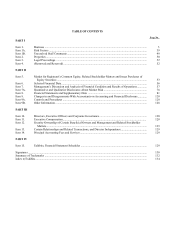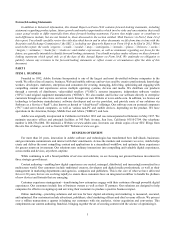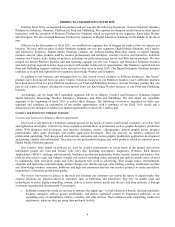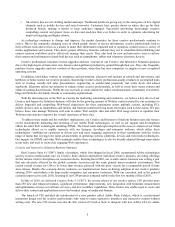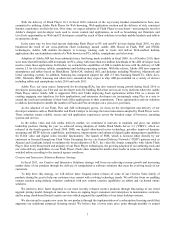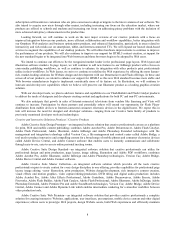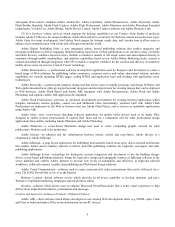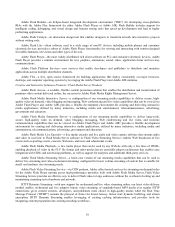Adobe 2010 Annual Report Download - page 7
Download and view the complete annual report
Please find page 7 of the 2010 Adobe annual report below. You can navigate through the pages in the report by either clicking on the pages listed below, or by using the keyword search tool below to find specific information within the annual report.7
With the delivery of Flash Player 10.1 in fiscal 2010, nineteen of the top twenty handset manufacturers have now
committed to utilizing Adobe Flash Player for Web browsing, Web application creation and the delivery of rich, consistent
Internet experiences on their devices. Over time, we expect adoption of Flash Player to accelerate—increasing the need for
Adobe’ s designer and developer tools used to create content and applications, as well as broadening our Omniture and
LiveCycle opportunities as Web and IT developers extend the reach of their solutions to include mobile handsets and tablets
as enterprise clients.
In the same way we have had success deploying Flash Player to PC and non-PC devices during fiscal 2010, we also
broadened the reach of our cross-platform client technology named Adobe AIR. Based on Flash, PDF and HTML
technologies, Adobe AIR enables developers to leverage existing code to create and deliver Web-enabled desktop
applications that run standalone outside of a Web browser on PCs, tablets, smartphones and televisions.
Adoption of Adobe AIR has been substantial since first being made available in fiscal 2008. As of October 2010, there
were more than 400 million AIR downloads on PCs, along with more than one million downloads of the AIR developer tools
used to create these applications. In October, we extended the capabilities of AIR to mobile devices with the delivery of AIR
version 2.5 for televisions, tablets, smartphones and desktop operating systems. With this release, Adobe AIR now supports
smartphones and tablets based on BlackBerry Tablet OS, Android, iOS, and desktops including Windows, Macintosh and
Linux operating systems. In addition, Samsung has integrated support for AIR 2.5 into Samsung SmartTVs, while Acer,
HTC, Motorola, RIM, Samsung and others have announced they expect to ship AIR pre-installed on a variety of devices
including tablets and smartphones in late 2010 and early 2011.
Adobe Flex, our open source framework for developing RIAs, has also enjoyed strong growth during fiscal 2010 as
developers increasingly use Flex and our developer tools for building RIAs that can run on every platform where the Adobe
Flash Player and/or Adobe AIR is supported. ISVs and VARs deploying SaaS applications utilize Flex as a means for
creating engaging user interfaces for their applications, and enterprise developers are increasingly using Flex as a way to
extend the reach and usefulness of their back office applications to their constituents. These opportunities and our solutions
to address them helped to double the number of Flash and Flex developers on a year-over-year basis.
As the adoption of our Flash, Flex and AIR technologies grows, we focus on the development and delivery of our
developer solutions such as Flash Builder and Flash Catalyst to leverage the latest innovations adopted by Flash Player users.
These solutions ensure reliable, secure and rich application experiences across the broadest range of browsers, operating
systems and devices.
In the online video and rich media delivery market, we continued to innovate to maintain and grow our market
leadership position. During the year we achieved strong adoption of Adobe Flash Media Server 3.5 (“FMS”), which we
released in the fourth quarter of fiscal 2009. FMS, our digital video-based server technology, provides improved dynamic
streaming and HTTP delivery capabilities, performance improvements and enhanced digital rights management capabilities
for H.264 video and digital video recorder functionality. The launch of FMS, which is licensed either directly by our
customers or licensed through our Flash Video Streaming Service via Content Delivery Network (“CDN”) partners such as
Akamai and Limelight, helped to maintain the broad adoption of FLV, the video file format compatible with Adobe Flash
Player. Due to the broad reach and ubiquity of our Flash Player technologies, the growing adoption of our authoring tools and
our video delivery capabilities via our Flash Player, Flash video remains the market share leader in terms of worldwide video
watched online according to the research agency comScore.
Creative and Interactive Solutions Business Strategy
In fiscal 2011, our Creative and Interactive Solutions strategy will focus on achieving revenue growth and increasing
market share of our products through the delivery of comprehensive software solutions that meet the evolving needs of our
customers.
To help drive this strategy, we will deliver more frequent minor releases of some of our Creative Suite family of
products during the year to help our customers stay current with evolving technology trends. We will also focus on enabling
content creation using desktop solutions combined with new content creation capabilities on tablets and via hosted online
solutions.
We intend to drive faster migration to our most recently released creative products through fine-tuning of our tiered
upgrade pricing model, through an increase in focus on signing larger customers and enterprises to maintenance contracts,
and by using cloud-based hosted creative services which augment the capabilities of our latest desktop versions.
We also intend to acquire new users for our products through the implementation of a subscription licensing model that
augments our traditional perpetual licensing model. We believe that a lower entry price point through monthly or annual


